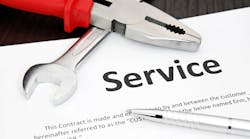Don’t let the title fool you. Service agreements are one of the most important things your business can get involved in. In fact, I would go so far as to say that your company should create a culture that is built around service agreements and make selling them your main purpose. Why? Because selling service agreements leads to everything else you want from your business.
You are looking for a price that is low enough to make investing in a SA an absolute “no brainer,” but high enough that you don’t dig yourself a financial hole too deep to get out of.
Service agreements (SAs) are critical to increasing the value of your company, increasing cash-flow, improving profitability and decreasing employee turnover. SAs increase the value of your business because potential buyers usually value them over anything else. SAs improve cash-flow because you get paid for services you have not yet provided. SAs improve profitability by increasing service revenue, increasing accessory sales, and by creating high quality replacement sales opportunities. SAs decrease employee turnover because they allow managers to keep their employees busy during slower times of the year.
Service agreements can also cause your company serious problems when not properly implemented.
Here are top three ways a company loses money with service agreements:
- They send a “parts changer:” A parts changer replaces parts only when there is a complete failure. This is bad for the company and bad for the customer. The person you need to send thinks more like an aircraft mechanic. They look for abnormal wear and address issues before they result in a complete failure. This person will sell legitimate repair work when the parts changer won’t.
- They offer discounts they cannot afford: If your service department generates a net profit of say 10 percent and you offer your SA clients a 15 percent discount, you are losing 5 percent of every transaction. Before you implement a SA program, be sure you have calculated your true net profit for service work. You accomplish this by printing out a departmentalized income statement for the service department. Most accounting software will not breakout your overhead by department. If that is the case, you will need to do it manually. You must know what your net profit is, so that you do not create losses by offering discounts you cannot afford.
- They price their labor too low: It is vital that you know how much it costs to provide labor. Your service agreements mostly consist of labor and they should generate more billable repair work. It is vital that you price your labor correctly before you begin selling SAs.
Loss Leaders and Pricing
A "loss leader" is a product that retailers sell at or below cost for marketing purposes. An example might be a case of pop. Retailers are willing to sell pop below cost to get you in the store in hopes of selling you additional products. Service agreement sales are a marketing strategy. Therefore, they can be thought of as loss leaders. You are looking for a price that is low enough to make investing in a SA an absolute “no brainer,” but high enough that you don’t dig yourself a financial hole too deep to get out of. This might mean that your service agreements are priced close to your break-even — that’s fine. The price of your SA should be slightly lower than what you charge separately for the services it includes. Let’s say you charge $98 for a tune-up. A two visit SA should sell for about $186 while a three visit might be priced at $274.
You should have approximately 250 SAs per $1 million of service sales, or about 250 SAs per billable service employee.
Marketing and Selling the Service Agreement
You should advertise a “clean and check” using whatever method has worked for you in the past. Give this service a more appropriate name such as “high performance tune-up” or “precision tune-up.” Establish a “loss leader” price such as $99. After performing the tune-up, the technician will work to convert a single tune-up sale to a service agreement sale that includes three visits.
Here is how the service tech might explain it: “Today’s high performance tune-up will cost $90. If you were to invest two fifty-seven ($257) in a service agreement, you would receive three high performance tune-ups, a 15 percent discount on any approved repairs and priority dispatching. Best of all, I can make today’s high performance tune-up the first one under your agreement.”
James Leichter will be a featured presenter at Contractor Leadership LIVE
Today’s visit will be considered the first visit with two more visits roughly six months apart. The idea is to get your technician back in their home — as close to the expiration date as possible and renew the SA to the standard two-visit type. You should be able to convert 60 percent of your tune-ups into a SA sale.
After performing a demand service call, the technician will offer the client an opportunity to invest in a SA and still get the 15 percent discount.
Here is what the tech might say: “Your total investment for today’s repair is four eighty-nine sixty-two is four eighty-nine sixty-two ($489.62). Do you own one of our High Performance Service Agreements? You don’t! Okay. I just wanted to see if you qualified for the seventy-three dollars and forty-four cent ($37.44) discount. If you would like to invest just one seventy-eight ($178) in a service agreement, I can go ahead and give you the seventy-three dollars and forty-four cent ($73.44) discount as if you already owned one. In addition, you will receive two high performance tune-ups, a 15 percent discount on any future repairs, and priority dispatching. Would you like to invest in our High Performance Service Agreement today?”
Be sure that your technicians call out each number when saying the discount. As a rule, techs should be able to convert 25 percent to 50 percent of their demand service calls into a SA sale.
SA Sales Goals
If your company does not have dedicated maintenance technicians, you want to have as many service agreements as it takes to fill in your slow time and keep your service technicians busy. You should have approximately 250 SAs per $1 million of service sales or about 250 SAs per billable service employee. Once you grow beyond those numbers, you can build a dedicated maintenance staff.
If your company does have dedicated maintenance technicians, your goal is 1,000 SAs per $1 million of residential sales (service/maintenance/accessories) with a best in class target of 1,500.
Suggestions for Implementation
- Owners and managers have to be committed to this process.
- Someone has to own this project. Assign a champion to oversee every aspect of it.
- Be sure you price everything properly. You need departmentalized income statements and you need to know your breakeven on labor. Don’t use multipliers or rules of thumb. You have to get this part right.
- Set goals for SA sales and post the progress on a score board for everyone to see.
- Create a SA culture. Train technicians on selling SAs. Be sure they believe in your SA program.
- Pay spiffs to technicians for selling them and pay your office staff a bonus when monthly SA sales goals are met.
successful and profitable SA program.
James Leichter is a founding faculty member at EGIA Contractor University. Learn more about EGIA and Contractor University. He is longtime HVAC contractor, consultant, and public speaker. Leichter is president and CEO at Aptora Corporation, a maker of contracting business management software. He is the editor of MrHVAC.com.










